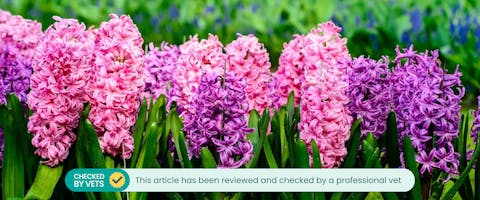Updated 29/09/2023
Native to the Mediterranean and countries further east, hyacinths have certainly made an impression in the spring flowers game. With many of us planting these tall and vibrant natural beauties in our gardens, it begs the questions - are hyacinths poisonous to dogs or can dogs eat hyacinth? Here we’re exploring whether hyacinths are a safe flower choice for pet parents, and if our pup pals should be around the plants at all.
Trending posts
Purr-use some of the top blogs our members have been loving this month- Top male dog names for your new furry friendGot a new furry family member in your pack? Check…

- Top female dog names for your new fluffy palWelcoming a new pooch into your family? Explore…

- 250+ gray cat names your silver feline will loveRecently welcomed a fluffy gray bundle of joy into…

- What are normal pet sitting rates?Discover the average pet sitting rates for animals…

- Unique dog names to stand out from the packDare to be different with our list of the best…

Are hyacinths poisonous to dogs?
So, is hyacinth poisonous to dogs? Certainly - and they’re not exactly safe for us humans, either. Let us explain - the dust from hyacinth bulbs can cause serious irritation in the lungs (and can even cause an asthma attack in us humans). But what makes hyacinths toxic to dogs is the presence of calcium oxalate crystals. Sitting in all areas of the plants (with the highest concentration in the bulbs), these crystals are shaped like needles, and unfortunately can pierce the soft tissue in your pup’s mouth and intestines. It’s no surprise that this can cause serious pain (which often deters our pooch pals from eating enough to cause toxicity), but if enough of the plant is consumed, more serious can symptoms occur which we’ll explore in more detail below.
Hyacinth poisoning in dogs
So, now we know that hyacinths and dogs aren’t a match made in doggy heaven, what are the symptoms of hyacinth poisoning in dogs? And how might your pup be treated if their curiosity gets the better of them, and they somehow eat enough of the stuff to cause toxicity? Well we’ll explore all of that below, but first - a small word of warning. If you think your pup has ingested even the smallest amount of a hyacinth plant, you should get to a veterinarian as a matter of emergency, even if symptoms haven’t started to show yet. The sooner your pup receives medical care, the less severe the symptoms may become. And now, without any further ado, let’s learn a little more about hyacinth poisoning in dogs.
Symptoms
Hyacinth is seriously poisonous to dogs, so here are the symptoms your poor pooch might experience if they’ve chowed down on any part of the plant.
Symptoms of poisoning caused by ingestion include (but are not limited to):
- Diarrhea
- Nausea
- Vomiting
- Tremors
- Abnormal breathing
- Convulsions
- Increased heart rate
- Seizures
- Spasms
Symptoms of poisoning caused by inhalation include (but are not limited to):
- Coughing
- Wheezing
- Shortness of breath
Symptoms of poisoning caused by topical exposure include (but are not limited to):
- Skin inflammation
- Itching
- Blisters
Diagnosis
If you can, take a sample of the plant your pup ingested with you to your vet - accurately identifying the hyacinth will help to speed up diagnosis and treatments. Also, note down any detail that you can remember (e.g. amount of plant ingested, date and time of ingestion, and whether other plants were ingested). Your vet will take a thorough history, so accurate and detailed information also will help your vet to choose the right treatments. Below are some of the methods that your vet will use to determine the right treatments for your dog:
- Thorough history-taking (as mentioned above)
- Physical examination of your dog (includes assessing weight, blood pressure, temperature, pupil reaction time, reflexes, coat and skin condition, respiration)
- Blood tests to check for organ damage
- X-ray to look for signs of a tummy blockage (aka an “obstructive pattern”) caused by the plant material
Treatments
Your vet’s treatment plan may include any of the following:
- Oxygen supplementation for any breathing difficulties
- IV fluids for dehydration from vomiting and diarrhea
- Induced vomiting
- Activated charcoal to soak up remaining poison
- Anti-nausea medication
- Washing of affected skin and application of anti-itch creams
While you may be tempted to administer at-home treatments to your dog before bringing him to the vet, do not administer any at-home treatments before consulting your vet! Each poisoning case is unique and not all pets are suited for at-home treatments. For instance, it’s dangerous to induce vomiting in dogs that are showing neurological symptoms.
Meet our veterinary expert, Jnanee
This article has been checked by veterinarian Jnanee Krishnasamy, BVSc (Massey). Dr Jnanee is a small animal veterinarian. She was born in sunny Singapore and spent her formative years there, before studying veterinary medicine at
Massey University. Since graduating from vet school, Dr Jnanee has worked in a variety of settings that include private practice, shelter medicine, and veterinary telemedicine. Due to her varied experiences, she is well-informed on many aspects of the veterinary industry!
Other plants poisonous to dogs
It turns out that we humans need to be incredibly careful if we like to decorate our gardens with all kinds of colorful and exotic plants and flowers, as many plants are poisonous to dogs. Get in the know on what’s safe for your pup to sniff, starting with those below.

